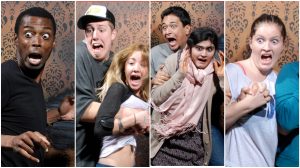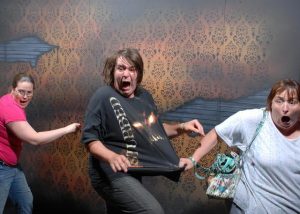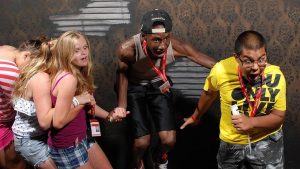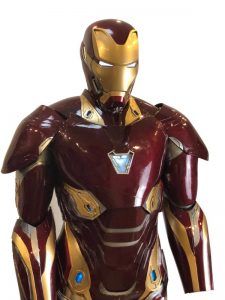
Photos are the property of Nightmares Fear Factory
This is an update from a post originally shared October 2015
The most current science on pain, tells us pain is an experience and not a sensation. Yes, we use words to describe our pain in terms of sensation (stabbing, aching, dull, throbbing, nagging, etc.), but there are many factors that contribute to just exactly how each of us get to the point where this pain is demanding our attention. Associated with this pain event are the many biological, psychological, and social elements that were present before, during and after the “experience”.
Many of you will be familiar by now with the bio-psycho-social paradigm used to better understand the pain experience. This video interview I did will help explain if you are not familiar.
The “Haunted House Effect” is a brilliant metaphor to add insight into our own experience.

We have all heard the saying “frozen with fear”. It is that brief but profound period of time where something is so shocking or terrifying that one cannot move. The body does not respond because the brain is overwhelmed with the danger or threat of danger at hand.
Similarly, consider what happens to your body and you mind the moment you have the fright of your life in a haunted house. The image above is from the web site Nightmares Fear Factory. They are hugely popular images on the internet of visitors caught at a moment in time inside the Nightmares Fear Factory’s haunted house.
If we got a little “sciencey” here and thought about all the things that happen to the body as this photo is taken and for the short time after, we would observe:
A huge dump of stress hormones entering the blood stream (adrenaline, cortisol)
The heart rate and blood pressure spike
Blood vessels dilate
Pupils dilate
Breathing gets rapid and shallow
Muscles all around the joints contract and stiffen the body
Posture instinctively goes into a flexed protection mode
Ensuing movement is guarded and apprehensive
Language to express the experience are dramatic and emotionally charged
I purposely used boxes in the list above because I want you to think of “ticking the boxes”. In the haunted house examples, these are boxes that are “ticked” when an extreme scare has occurred. Now let us imagine these events happened within the first 5 minutes of a scheduled 30-minute tour through the haunted house. They still have 25 more minutes to take part in an experience where the tone has been clearly established as frighteningly intense.

So, what happens when they approach that next corner that they cannot see past? Are they relaxed and at ease? Absolutely not! Their body will reproduce the identical events it did from the first scare. Except all those responses will happen before they even get to the corner.
As they cautiously approach the blind corner, and their body is in full anticipation mode-anticipation of the next blood curling scare-they turn the corner to see a unicorn and rainbows.
No threat exists at this corner. Yet their body and mind went through all the same events as if the next big scare actually took place. That pattern continues through the remainder of the tour with each anticipation of the scares almost as physically and mentally real as a scare itself.
The source (which we cannot see) that created those responses in the photos is not the only part of that scare experience. Although likely not as obvious to those in the photos, the entire experience includes the people they are with, the smell of the room, the temperature of the room, the sounds and even how their clothes fit. And as the remainder of the tour continues, they all become part of the biological, psychological, and social contribution to that experience.
Now consider this scenario. After the first scare event, the participants get to put on full body armor and carry a 4-foot taser wand that can keep anyone or anything at least 4 feet away. Do you think this would increase their confidence and decrease the threat as they approached the ensuing corners? I would suggest it does make them safer and more confident. Perhaps they will have some fear, but not nearly as intense now that they have these protective “tools”.

So, what has this got to do with someone dealing with chronic pain? The scenarios can be almost identical except replace “scare” with “pain”. Let us say for example that after a long flight you felt a pop in your back as you lowered your carryon from the overhead bin. You begin to feel your back tighten up and you experience the pain ramping up as you exit the plane. Beginning with the “pop” you felt, you would begin to experience those same 7 traits listed earlier. And whether you realized it or not, the physical pain itself is not the only part of the experience. The people you are with, the smell of the airplane and then the terminal, the temperature, the sounds and even how your clothes fit all become part of the biological, psychological and social contribution to that pain experience.
These combined elements begin to form a neuro signature or neuro representation in your brain. Over the next couple of days as you are recovering from this episode, you experience those 9 traits (boxes to tick) any time you anticipate potential threat to your back. This could be something as familiar as putting on your socks. Some movements may in fact provoke pain, but others may not. Yet the net result is remarkably similar in terms of your physiological and mental response.
You can clearly see how patterns emerge that are counterproductive to your long-term goals. And the reality of this is that we can’t, and you can’t explain your way through process. Yes, you need an understanding, but your body and brain also need proof. This is where a strategic and structured corrective exercise plan can create the movement confidence you need to no longer anticipate a threat when the threat is not valid. The proper, strategic exercise program for you becomes your full body armor and 4-foot laser wand.
Pain is an extraordinarily complex experience for everyone. And many people will attempt to chase one aspect or another of their pain. The science now tells us that we must look at the entire bio-pyscho-social context from which chronic pain is experienced.
Don’t live your life waiting for the next ghost or goblin around the corner. Suit up, educate yourself and show your brain that you are not broken.
Happy Halloween!
Tags: biopyschosocial, Halloween, lower back pain, pain science, understanding pain
I have a question. What if you got pain in some places and nobody touched you or anything and you didn’t get hurt? You were in a haunted house too and it was different places that hurted and we’re not hurt anymore later on. What is that then?
Hi Haili. I’m not fully following. Are you saying that the pain moves around and you coincidentally were in haunted house?